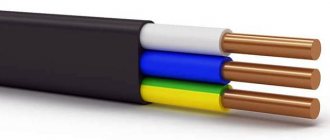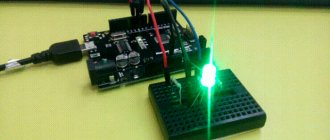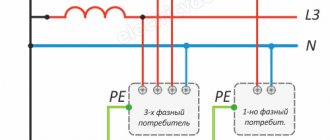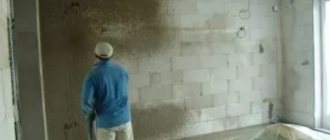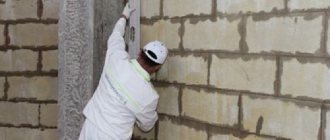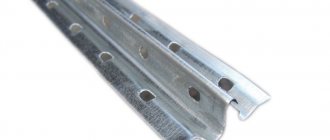Proper plastering of the facade of a building allows not only to improve the house and give it a finished look. Reinforcing facade mesh is also used to protect walls from the harmful effects of rain, wind, severe frost and ultraviolet radiation, which is contained in the spectrum of sunlight. But often, after applying a layer of plaster, the hardened cement-sand mixture becomes covered with cracks and collapses over time.
This happens for various reasons - due to the natural shrinkage of the building (which is typical for recently constructed structures or objects erected on weak soil), due to the low quality of facing materials, weather influences, etc. A building façade mesh can solve this problem.
Why do you need a façade mesh?
Facade mesh under plaster is used as a “frame” that strengthens the cement-sand layer and prevents its destruction. Before the advent of the technology of facade plastering on a grid, the plaster layer was strengthened using thin wooden planks. They were placed crosswise on the wall, and the solution was applied on top of them. After drying, the plaster became more durable and resistant to cracks. But this method has a significant drawback - the wooden planks rot over time, and the “frame” begins to collapse.
The use of thin metal rods as a replacement is impractical, since they have a large mass, which is why the plaster layer can collapse under its own weight. Facade fiberglass mesh is free of all the shortcomings that are characteristic of outdated methods of strengthening plaster.
How to attach the plaster mesh
To understand how to properly attach the mesh to the wall, it is worth considering the two most popular types of mesh - fiberglass and metal. It is much easier to secure the first named type of product, since for this you only need to screw in several screws at an equal distance from each other. Such fastenings are sufficient to securely hold the mesh.
To keep the mesh more securely, you should roll it out across its entire width in one piece, without dividing the product into several. Vertical beacons are installed at a distance of about two meters from each other during installation. After the mesh is hung on the screws, the plaster applied seals it to the wall, so additional fastening elements are not needed.
The installation process for metal mesh is slightly different. This is due to the fact that under its own weight such a product is not able to be securely held on the mounts. Also, the cells of metal mesh are large and require additional fastening with mounting tape.
To secure it, you only need to cut off part of the mounting tape so that it can completely cover one cell. After cutting the mounting tape, it is fixed to the wall with self-tapping screws. You need to calculate the distance between the fasteners in such a way that the mesh does not sag on any section of the wall.
What are the advantages of façade plaster mesh?
Reinforcing mesh used for plastering facade surfaces has a number of significant advantages:
- Allows you to improve the adhesion effect of different building materials. Without a mesh, the plaster has poorer contact with the surface of walls made of brick, aerated concrete and other materials, and over time can peel off from the facade;
- Strengthens corner elements and joints of structures that may be damaged when opening window or door openings;
- Forms a reliable monolithic frame that protects the cladding from premature cracks and chips;
- Prevents excessive internal wall stress due to temperature changes. This phenomenon may arise from the fact that the plaster material and the material from which the walls of the building are laid have different coefficients of thermal expansion;
- Allows you to give a respectable and beautiful look to the facade of the building.
Plastering walls
Fences with mesh are plastered in 2-3 layers.
The walls are plastered in several layers
The work is carried out in the following order:
- The first layer is applied using the cape method. The mortar collected on a trowel is thrown onto the fence with a sharp movement of the hand. To do this, use a mixture with a consistency reminiscent of liquid sour cream. This method of applying the solution allows you to obtain a dense, durable layer of plaster.
- After the first layer has “set”, the next layer of plaster is applied. The second layer is made from a denser mixture - a dough-like consistency.
- Plastering is done from bottom to top. The thrown solution from below is picked up with a rule and brought up. As the rule moves, it is slightly alternately shifted from side to side. This helps to distribute the mixture evenly over the wall surface.
- After the plaster has dried, the beacons are removed. The remaining clearings are sealed with mortar.
- At the end of the work, the surface of the walls must be grouted. To do this, take a liquid mixture. Using circular movements of a wooden grout or trowel, the liquid solution is rubbed onto the plastered wall, thereby finally forming the finished surface of the wall.
Types of facade mesh
Facade mesh for plaster can be made from different materials. Each type has its own advantages and disadvantages, and is used to solve different problems. Let's look at the features of the three most common types of facade walls:
Metal
Metal mesh for facades is used in cases where it is necessary to ensure high-quality reinforcement of a thick layer of plaster (more than 30 mm). It is quite strong and resistant to tearing, has a low coefficient of thermal expansion (due to which the plaster does not deteriorate in severe frosts), and is also characterized by high resistance to corrosion and alkalis (in the presence of a protective zinc layer on the mesh). In terms of price, such a mesh is more expensive than a plastic one, but this disadvantage is fully compensated by the excellent performance properties of the material.
Plastic
When there is no need to purchase an expensive metal mesh, builders use its plastic counterpart. Such products are much cheaper, because... polyvinyl chloride has a low cost. Plastic reinforcing façade mesh is suitable for use in cases where the plaster layer does not exceed 30 mm and does not place a large load on the façade of the building. The only nuances to remember: PVC materials are poorly protected from concentrated alkalis and have high rates of thermal expansion, which is why plastic products should not be used in regions with an unstable climate.
How not to make a mistake when choosing a façade mesh
When purchasing this building material, be careful and check the product carefully. If it turns out to be of poor quality, the façade of the building will not be sufficiently protected, and cracks and chips will quickly appear on the surface of the plaster layer. Therefore, when purchasing, make sure that the mesh for facade plaster meets the following requirements:
- It has sufficient density - about 150-170 g/sq.m.;
- Made from material resistant to corrosion and chemically aggressive substances;
- Its cells are absolutely identical in size and alternation;
- Highly resistant to tearing and excessive stretching;
- The product comes with documentation that contains test results carried out in independent laboratories.
What is the function of the grid
Plastering on a grid allows you to solve the following problems:
- strengthening the base and increasing the reliability of fixation of the plaster layer;
- preventing delamination of the decorative plaster layer;
- alignment of deformations, chips, cracks;
- long-term maintenance of the integrity of the plaster coating;
- the possibility of implementing textured plaster coatings (“Venetian”, “bark beetle”, stone or wood);
- increasing the thermal insulation functions of the coating;
- increasing the resistance of walls to loads;
- improving sound insulation in the room.
Tips for novice repairmen
When applying plaster to the facade of a building using a grid, you should remember several important points:
Facade plaster over a reinforcing mesh is applied only in dry weather. The air temperature must be at least 5 degrees Celsius and the relative humidity must be at least 80%
Until the plaster is completely dry, the facing layer must be protected from wind, sunlight and precipitation. If the treated surfaces are unprotected, then after drying, defects and peeling of the plaster layer may be found on the facade.
Before starting work, you should prepare the walls for applying plaster. If the surface of the walls is not cleaned and leveled, the cement-sand layer may peel off from the wall.
The plaster material must be applied in a layer of sufficient thickness. If it turns out to be too thin, uneven walls will be noticeable on the façade.
It is also necessary to remember that if you do not have the proper experience and skills, it is better not to undertake plastering work yourself. Entrust this task to professional builders - this will avoid any mistakes, due to which in the future you will have to re-carry out facing procedures and spend extra money.
Similar articles
- Insulation for exterior walls of a house under plaster Plaster
systems.
When the insulation for the facade
under
plaster
is selected, it is necessary to purchase
...
reinforcing mesh
is glued onto the heat-insulating material (fiberglass is selected with cells whose size is 3-6 mm). Read more - Technology and secrets of painting facade bark beetle
Before painting
a facade
with decorative
plaster
, it is advisable to know about some of the features of this work.
...
How to use
reinforcing mesh for
a wet
facade
. Read more - Facade plaster: features and types
But it is necessary to take into account that the weight per square meter increases, the thickness increases, so it must be
reinforced with mesh
so that the
plaster
layer does not move away from
the facade
. Read more - Universal technology for plastering facades using…
Therefore, a dowel with a plastic head is used for
façade
plastering
systems .
...
Construction
of the plaster
layer.
the reinforcing mesh
is installed . Read more - Insulating the facade with mineral wool - modern technology
Insulation
of the facade
with mineral wool under
plaster
involves the creation of a multi-layer “fur coat”, which includes
... reinforcing mesh
made of fiberglass;
base plaster
layer Read more - Construction facade mesh
It is worth noting that
the construction
facade
mesh is not fiberglass or
facade
metal
mesh
.
...
So, what functions does the covering
mesh for the facade
? Read more
Scope and types of reinforcing mesh for plaster
In the recent past, the plaster layer was reinforced exclusively with wooden shingles. The modern construction industry offers users a much wider list of materials with different performance parameters. The range of reinforced fabric for construction and finishing works includes products from various materials, which imply a wide selection of properties, and therefore application options.
Polymer
Plastic or, as it is also called, masonry canvas for plastering walls is made from modern polymers. It is characterized by high strength characteristics, the thickness can be different, the shape of the cells is rhombuses or squares of different sizes, which led to the use of plastic sheeting in different areas of construction.
Variety of polymer meshes
As for the positive features, the following operational potential of plastic reinforcing mesh can be noted:
- Hydrophobicity
- Absence of corrosion and putrefactive processes
- Resistance to temperature changes
- Environmentally friendly - no toxins, does not cause allergies
- Elasticity – resistance to vibrations and mechanical loads
- There is no need to fix the canvas on the wall - just place it on the solution, which takes a minimum of time and will not delay the project’s delivery deadlines
- The mesh reinforces the plaster layer in the middle, which ensures uniform distribution of the reinforcement properties of the finishing layer
- Availability is one of the main positive features of this material, especially in comparison with other options for reinforcing materials.
As for the disadvantages, we can note:
- Limitation in the thickness of the plaster layer - the canvas can provide strengthening of the finishing layer no wider than 6-8 mm, otherwise the effectiveness of the reinforcement is reduced.
- Low-quality plastic, which can be used in the production of mesh, is not chemically resistant, and therefore interacts with alkalis and dissolves in them.
All these parameters determine the areas of use of plastic mesh - it is used to strengthen the finishing of walls during plastering work, and it can also be used to level walls, both internal and external.
Strengthening the finishing layer is no wider than 6-8 mm.
It is also capable of ensuring adhesion between the finishing and the insulation, in particular, polystyrene foam - the presence of a mesh in the cake eliminates the appearance of cracks and peeling of the plaster. You need to choose a material that is as rigid as possible with a large thickness of cells - such meshes are also used when arranging the foundation, they are laid between layers, strengthening the cushion of sand and gravel on unstable soils.
The most popular version of polymer reinforcing fabric is with square-shaped cells and dimensions of 5x5 mm.
Fiberglass
Fiberglass reinforcing mesh boasts all the performance characteristics of a plastic material. But unlike polymers, fiberglass exhibits chemical resistance, increased strength and higher tensile strength. The parameters of the fiberglass sheet largely depend on the size of the cells; also, to evaluate the characteristics of the mesh, the so-called density is used, which is measured in g/m2. Based on network density, they can be divided into three groups:
- Density within 50-160 g/m2. Suitable for work inside the house. Grids are divided into plaster and painting - the latter demonstrate lower density, and the standard cell sizes are respectively 2x2, 3x3, 2.5x2.5 mm. In plaster sheets, the cell size is significantly larger - the most popular options are 5x5 mm, the density of such a product is also higher.
- Density within 160-220 g/m2. – used for plastering and puttying on facade walls. The most common cell sizes are 5x5 and 10x10 mm.
- Density within 220-300 g/m2. – this mesh is used for the basement and underground part of the building. The use of reinforcement provides the finish with anti-vandal properties, since it is able to withstand severe mechanical and impact loads. Due to the larger amount of material used in the production of such materials, their price will also be higher.
Density within 160-220 g/m2.
In order not to be mistaken about the purpose of the mesh, it is worth understanding the rules for marking such material:
- C – network;
- CC – fiberglass sheet;
- N – exterior finishing;
- B – interior decoration;
- Ш – for painting work;
- A – base anti-vandal;
- U – with amplification.
Manufacturers indicate information about the technical characteristics of the material on the packaging.
In production, fiberglass mesh goes through the stage of increasing resistance to an alkaline environment, which is relevant for putty and plaster solutions. To prevent the fabric from dissolving in a weak or medium alkaline solution, the fiberglass is impregnated with a polyacrylic dispersion, which reduces the aggressive effects of an alkaline environment.
This mesh is sold in the form of a 1m wide sheet, sometimes the material is sold in the form of cut rectangles. The material is actively used for reinforcing seams, corners, etc.
Metal
Metal facade mesh for plaster can strengthen not only the plaster layer, but also the walls themselves. This mesh is the most common option for finishing facades, plinths, and so on.
Can strengthen not only the plaster layer, but also the walls themselves
The choice of material is determined by its purpose, which determines the size of the cells, the thickness of the wire, and the method of fastening metal rods/wires:
- When plastering, a woven metal mesh is used, the structure of which resembles the structure of fabric, only metal wire is used instead of thread. The main characteristics of this material are small cells measuring from 1 to 2 mm or more. The wire used for the manufacture of such networks is protected from corrosion destruction, and therefore can be made of either stainless steel or carbon steel, but with protection from a layer of zinc or polymers.
- Chain-link is also considered in demand - due to its large cells, it creates a reinforcing relief layer that allows you to hold a thick layer of finishing material on the wall.
- Welded mesh made of wire rods welded to each other is also used to strengthen the masonry of walls, installation work, strengthening load-bearing surfaces, foundations, and so on.
- Masonry mesh is another version of a metal reinforcing material that is used for strengthening walls, plastering, pouring screeds, and so on.
- Plaster network made of metal is used exclusively for plastering. It is made from hot-dip galvanized wire, and therefore is not susceptible to corrosion.

